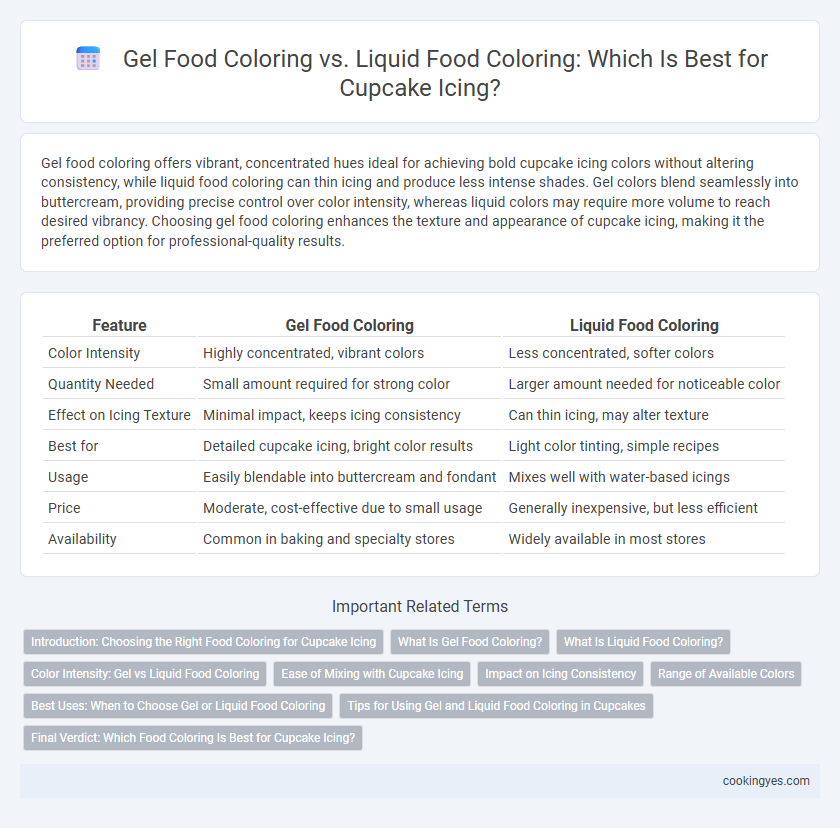Gel food coloring offers vibrant, concentrated hues ideal for achieving bold cupcake icing colors without altering consistency, while liquid food coloring can thin icing and produce less intense shades. Gel colors blend seamlessly into buttercream, providing precise control over color intensity, whereas liquid colors may require more volume to reach desired vibrancy. Choosing gel food coloring enhances the texture and appearance of cupcake icing, making it the preferred option for professional-quality results.
Table of Comparison
| Feature | Gel Food Coloring | Liquid Food Coloring |
|---|---|---|
| Color Intensity | Highly concentrated, vibrant colors | Less concentrated, softer colors |
| Quantity Needed | Small amount required for strong color | Larger amount needed for noticeable color |
| Effect on Icing Texture | Minimal impact, keeps icing consistency | Can thin icing, may alter texture |
| Best for | Detailed cupcake icing, bright color results | Light color tinting, simple recipes |
| Usage | Easily blendable into buttercream and fondant | Mixes well with water-based icings |
| Price | Moderate, cost-effective due to small usage | Generally inexpensive, but less efficient |
| Availability | Common in baking and specialty stores | Widely available in most stores |
Introduction: Choosing the Right Food Coloring for Cupcake Icing
Gel food coloring offers intense hues and requires less quantity, making it ideal for vibrant cupcake icing without thinning the consistency. Liquid food coloring, while more accessible and easy to mix, can dilute the icing and produce softer colors. Selecting gel coloring ensures rich, vivid cupcake decorations that maintain perfect texture.
What Is Gel Food Coloring?
Gel food coloring is a concentrated coloring agent with a thicker consistency than liquid food coloring, making it ideal for vibrant and intense hues in cupcake icing without altering the icing's texture. It contains less water, allowing it to blend smoothly into buttercream and fondant without thinning the icing, ensuring a stable and rich color payoff. Compared to liquid food coloring, gel colors provide more precise control over color intensity and longer-lasting results in decorative bakery applications.
What Is Liquid Food Coloring?
Liquid food coloring is a water-based dye commonly used to tint cupcake icing, offering easy blending and vibrant colors. It is ideal for thin, smooth icings but may alter the consistency of thicker frostings like buttercream. Compared to gel food coloring, liquid food coloring provides a more translucent finish and requires larger quantities to achieve deeper hues.
Color Intensity: Gel vs Liquid Food Coloring
Gel food coloring offers richer, more vibrant color intensity for cupcake icing compared to liquid food coloring, which tends to produce softer, more diluted hues. The concentrated pigments in gel coloring require less quantity to achieve bold shades, preserving the icing's consistency without making it runny. Liquid food coloring, while easier to mix, often necessitates larger amounts, potentially thinning the icing and resulting in less vivid colors.
Ease of Mixing with Cupcake Icing
Gel food coloring offers concentrated pigments that mix seamlessly into cupcake icing, producing vibrant colors without altering the consistency. Liquid food coloring tends to dilute the icing, requiring more product for desired hues and often resulting in a runnier texture. For ease of mixing and maintaining the perfect icing texture, gel food coloring is the preferred choice among bakers.
Impact on Icing Consistency
Gel food coloring delivers vibrant, concentrated hues without thinning cupcake icing, preserving a thick, smooth consistency ideal for detailed decorating. Liquid food coloring can dilute the icing, making it runnier and harder to pipe, which may compromise intricate designs. Choosing gel over liquid ensures stable icing texture and richer color intensity for professional-quality cupcakes.
Range of Available Colors
Gel food coloring offers a more concentrated and vibrant range of colors compared to liquid food coloring, making it ideal for achieving intense and rich hues in cupcake icing. The gel formula allows for precise shading and blending, expanding the palette with deep blues, bright reds, and vivid greens that liquid colors typically cannot match. Liquid food coloring provides a limited spectrum and tends to dilute the icing, resulting in softer, less consistent colors.
Best Uses: When to Choose Gel or Liquid Food Coloring
Gel food coloring offers vibrant, intense hues ideal for thick cupcake icings like buttercream, allowing for precise color control without altering consistency. Liquid food coloring suits thinner icings or batter, providing subtle shades while maintaining a smooth texture. Choose gel for bold, concentrated colors in dense frostings and liquid for light tinting in delicate cupcake applications.
Tips for Using Gel and Liquid Food Coloring in Cupcakes
Gel food coloring offers concentrated pigment that enhances cupcake icing with vibrant hues without thinning the frosting, making it ideal for precise color control. Liquid food coloring, though less intense, blends well for subtle pastel shades but may require adjusting icing consistency to maintain texture. When using either type, start with small amounts to gradually achieve the desired color, mixing thoroughly to avoid streaks and ensure uniform coverage on cupcake icing.
Final Verdict: Which Food Coloring Is Best for Cupcake Icing?
Gel food coloring is best for cupcake icing due to its concentrated pigment, which provides vibrant colors without altering the icing's consistency. Liquid food coloring can thin the icing, making it harder to achieve smooth, firm decorations. Gel colors offer better control and intensity, ensuring visually appealing and richly colored cupcake icing.
Gel Food Coloring vs Liquid Food Coloring for Cupcake Icing Infographic

 cookingyes.com
cookingyes.com